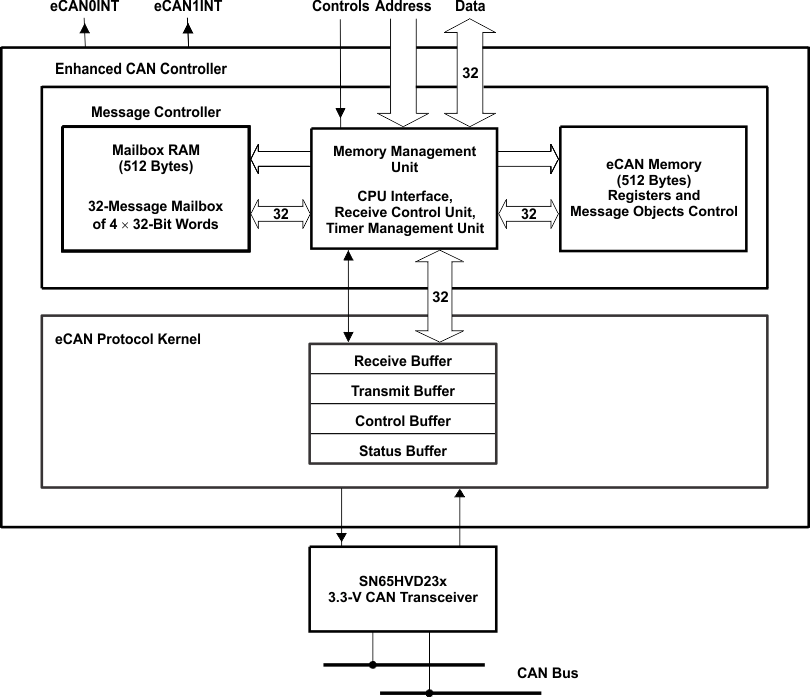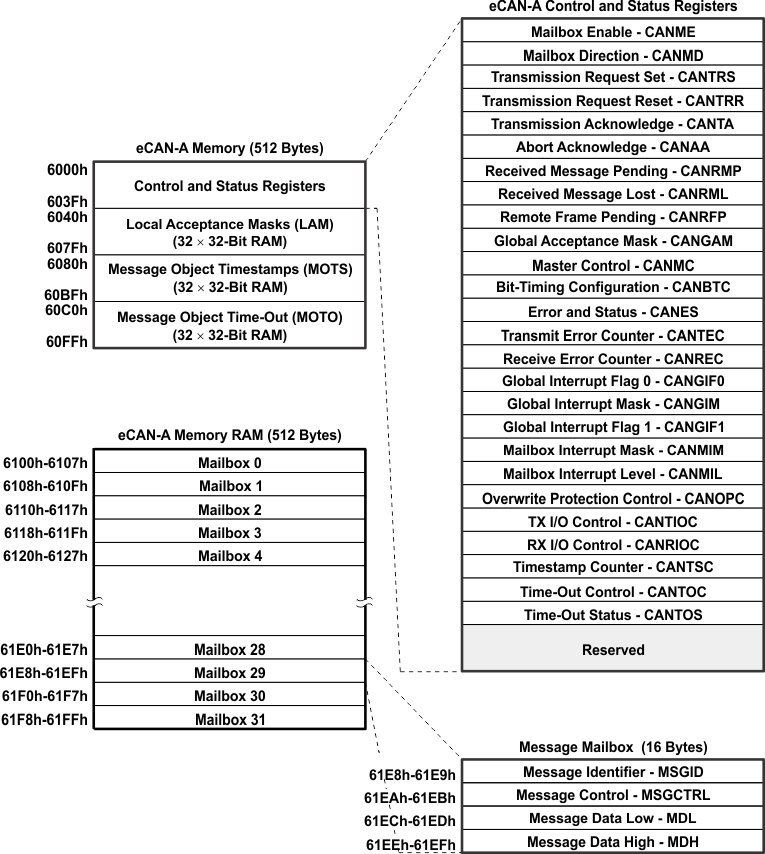SPRS698J November 2010 – September 2021 TMS320F28062 , TMS320F28062F , TMS320F28063 , TMS320F28064 , TMS320F28065 , TMS320F28066 , TMS320F28067 , TMS320F28068F , TMS320F28068M , TMS320F28069 , TMS320F28069F , TMS320F28069M
PRODUCTION DATA
- 1 Features
- 2 Applications
- 3 Description
- 4 Revision History
- 5 Device Comparison
- 6 Terminal Configuration and Functions
-
7 Specifications
- 7.1 Absolute Maximum Ratings
- 7.2 ESD Ratings – Commercial
- 7.3 ESD Ratings – Automotive
- 7.4 Recommended Operating Conditions
- 7.5 Power Consumption Summary
- 7.6 Electrical Characteristics
- 7.7 Thermal Resistance Characteristics
- 7.8 Thermal Design Considerations
- 7.9 Debug Probe Connection Without Signal Buffering for the MCU
- 7.10 Parameter Information
- 7.11 Test Load Circuit
- 7.12 Power Sequencing
- 7.13 Clock Specifications
- 7.14 Flash Timing
-
8 Detailed Description
- 8.1
Overview
- 8.1.1 CPU
- 8.1.2 Control Law Accelerator (CLA)
- 8.1.3 Viterbi, Complex Math, CRC Unit (VCU)
- 8.1.4 Memory Bus (Harvard Bus Architecture)
- 8.1.5 Peripheral Bus
- 8.1.6 Real-Time JTAG and Analysis
- 8.1.7 Flash
- 8.1.8 M0, M1 SARAMs
- 8.1.9 L4 SARAM, and L0, L1, L2, L3, L5, L6, L7, and L8 DPSARAMs
- 8.1.10 Boot ROM
- 8.1.11 Security
- 8.1.12 Peripheral Interrupt Expansion (PIE) Block
- 8.1.13 External Interrupts (XINT1 to XINT3)
- 8.1.14 Internal Zero Pin Oscillators, Oscillator, and PLL
- 8.1.15 Watchdog
- 8.1.16 Peripheral Clocking
- 8.1.17 Low-power Modes
- 8.1.18 Peripheral Frames 0, 1, 2, 3 (PFn)
- 8.1.19 General-Purpose Input/Output (GPIO) Multiplexer
- 8.1.20 32-Bit CPU-Timers (0, 1, 2)
- 8.1.21 Control Peripherals
- 8.1.22 Serial Port Peripherals
- 8.2 Memory Maps
- 8.3 Register Maps
- 8.4 Device Debug Registers
- 8.5 VREG, BOR, POR
- 8.6 System Control
- 8.7 Low-power Modes Block
- 8.8 Interrupts
- 8.9
Peripherals
- 8.9.1 CLA Overview
- 8.9.2 Analog Block
- 8.9.3 Detailed Descriptions
- 8.9.4 Serial Peripheral Interface (SPI) Module
- 8.9.5 Serial Communications Interface (SCI) Module
- 8.9.6
Multichannel Buffered Serial Port (McBSP) Module
- 8.9.6.1
McBSP Electrical Data/Timing
- 8.9.6.1.1 McBSP Transmit and Receive Timing
- 8.9.6.1.2
McBSP as SPI Master or Slave Timing
- 8.9.6.1.2.1 McBSP as SPI Master or Slave Timing Requirements (CLKSTP = 10b, CLKXP = 0)
- 8.9.6.1.2.2 McBSP as SPI Master or Slave Switching Characteristics (CLKSTP = 10b, CLKXP = 0)
- 8.9.6.1.2.3 McBSP as SPI Master or Slave Timing Requirements (CLKSTP = 11b, CLKXP = 0)
- 8.9.6.1.2.4 McBSP as SPI Master or Slave Switching Characteristics (CLKSTP = 11b, CLKXP = 0)
- 8.9.6.1.2.5 McBSP as SPI Master or Slave Timing Requirements (CLKSTP = 10b, CLKXP = 1)
- 8.9.6.1.2.6 McBSP as SPI Master or Slave Switching Characteristics (CLKSTP = 10b, CLKXP = 1)
- 8.9.6.1.2.7 McBSP as SPI Master or Slave Timing Requirements (CLKSTP = 11b, CLKXP = 1)
- 8.9.6.1.2.8 McBSP as SPI Master or Slave Switching Characteristics (CLKSTP = 11b, CLKXP = 1)
- 8.9.6.1
McBSP Electrical Data/Timing
- 8.9.7 Enhanced Controller Area Network (eCAN) Module
- 8.9.8 Inter-Integrated Circuit (I2C)
- 8.9.9 Enhanced Pulse Width Modulator (ePWM) Modules (ePWM1 to ePWM8)
- 8.9.10 High-Resolution PWM (HRPWM)
- 8.9.11 Enhanced Capture Module (eCAP1)
- 8.9.12 High-Resolution Capture Modules (HRCAP1 to HRCAP4)
- 8.9.13 Enhanced Quadrature Encoder Modules (eQEP1, eQEP2)
- 8.9.14 JTAG Port
- 8.9.15 General-Purpose Input/Output (GPIO) MUX
- 8.9.16 Universal Serial Bus (USB)
- 8.1
Overview
- 9 Applications, Implementation, and Layout
- 10Device and Documentation Support
- 11Mechanical, Packaging, and Orderable Information
Package Options
Mechanical Data (Package|Pins)
Thermal pad, mechanical data (Package|Pins)
Orderable Information
8.9.7 Enhanced Controller Area Network (eCAN) Module
The CAN module (eCAN-A) has the following features:
- Fully compliant with CAN protocol, version 2.0B
- Supports data rates up to 1 Mbps
- Thirty-two mailboxes, each with the following properties:
- Configurable as receive or transmit
- Configurable with standard or extended identifier
- Has a programmable receive mask
- Supports data and remote frame
- Composed of 0 to 8 bytes of data
- Uses a 32-bit timestamp on receive and transmit message
- Protects against reception of new message
- Holds the dynamically programmable priority of transmit message
- Employs a programmable interrupt scheme with two interrupt levels
- Employs a programmable alarm on transmission or reception time-out
- Low-power mode
- Programmable wake-up on bus activity
- Automatic reply to a remote request message
- Automatic retransmission of a frame in case of loss of arbitration or error
- 32-bit local network time counter synchronized by a specific message (communication in conjunction with mailbox 16)
- Self-test mode
- Operates in a loopback mode receiving its own message. A "dummy" acknowledge is provided, thereby eliminating the need for another node to provide the acknowledge bit.
For a SYSCLKOUT of 90 MHz, the smallest bit rate possible is 6.25 kbps.
The F2806x CAN has passed the conformance test per ISO/DIS 16845. Contact TI for test report and exceptions.
 Figure 8-45 eCAN Block Diagram and Interface Circuit
Figure 8-45 eCAN Block Diagram and Interface Circuit| PART NUMBER | SUPPLY VOLTAGE | LOW-POWER MODE | SLOPE CONTROL | VREF | OTHER | TA |
|---|---|---|---|---|---|---|
| SN65HVD230 | 3.3 V | Standby | Adjustable | Yes | – | –40°C to 85°C |
| SN65HVD230Q | 3.3 V | Standby | Adjustable | Yes | – | –40°C to 125°C |
| SN65HVD231 | 3.3 V | Sleep | Adjustable | Yes | – | –40°C to 85°C |
| SN65HVD231Q | 3.3 V | Sleep | Adjustable | Yes | – | –40°C to 125°C |
| SN65HVD232 | 3.3 V | None | None | None | – | –40°C to 85°C |
| SN65HVD232Q | 3.3 V | None | None | None | – | –40°C to 125°C |
| SN65HVD233 | 3.3 V | Standby | Adjustable | None | Diagnostic Loopback | –40°C to 125°C |
| SN65HVD234 | 3.3 V | Standby and Sleep | Adjustable | None | – | –40°C to 125°C |
| SN65HVD235 | 3.3 V | Standby | Adjustable | None | Autobaud Loopback | –40°C to 125°C |
| ISO1050 | 3–5.5 V | None | None | None | Built-in Isolation Low Prop Delay Thermal Shutdown Fail-safe Operation Dominant Time-Out | –55°C to 105°C |
 Figure 8-46 eCAN-A Memory Map
Figure 8-46 eCAN-A Memory MapIf the eCAN module is not used in an application, the RAM available (LAM, MOTS, MOTO, and mailbox RAM) can be used as general-purpose RAM. The CAN module clock should be enabled for this.
The CAN registers listed in Table 8-31 are used by the CPU to configure and control the CAN controller and the message objects. eCAN control registers only support 32-bit read/write operations. Mailbox RAM can be accessed as 16 bits or 32 bits. All 32-bit accesses are aligned to an even boundary.
| REGISTER NAME(1) | eCAN-A ADDRESS | SIZE (×32) | DESCRIPTION | ||
|---|---|---|---|---|---|
| CANME | 0x6000 | 1 | Mailbox enable | ||
| CANMD | 0x6002 | 1 | Mailbox direction | ||
| CANTRS | 0x6004 | 1 | Transmit request set | ||
| CANTRR | 0x6006 | 1 | Transmit request reset | ||
| CANTA | 0x6008 | 1 | Transmission acknowledge | ||
| CANAA | 0x600A | 1 | Abort acknowledge | ||
| CANRMP | 0x600C | 1 | Receive message pending | ||
| CANRML | 0x600E | 1 | Receive message lost | ||
| CANRFP | 0x6010 | 1 | Remote frame pending | ||
| CANGAM | 0x6012 | 1 | Global acceptance mask | ||
| CANMC | 0x6014 | 1 | Master control | ||
| CANBTC | 0x6016 | 1 | Bit-timing configuration | ||
| CANES | 0x6018 | 1 | Error and status | ||
| CANTEC | 0x601A | 1 | Transmit error counter | ||
| CANREC | 0x601C | 1 | Receive error counter | ||
| CANGIF0 | 0x601E | 1 | Global interrupt flag 0 | ||
| CANGIM | 0x6020 | 1 | Global interrupt mask | ||
| CANGIF1 | 0x6022 | 1 | Global interrupt flag 1 | ||
| CANMIM | 0x6024 | 1 | Mailbox interrupt mask | ||
| CANMIL | 0x6026 | 1 | Mailbox interrupt level | ||
| CANOPC | 0x6028 | 1 | Overwrite protection control | ||
| CANTIOC | 0x602A | 1 | TX I/O control | ||
| CANRIOC | 0x602C | 1 | RX I/O control | ||
| CANTSC | 0x602E | 1 | Timestamp counter (Reserved in SCC mode) | ||
| CANTOC | 0x6030 | 1 | Time-out control (Reserved in SCC mode) | ||
| CANTOS | 0x6032 | 1 | Time-out status (Reserved in SCC mode) | ||